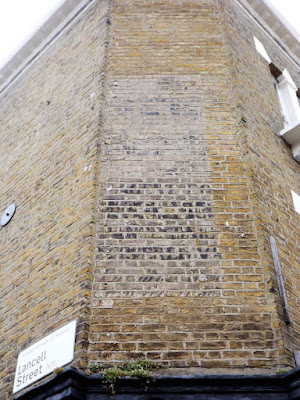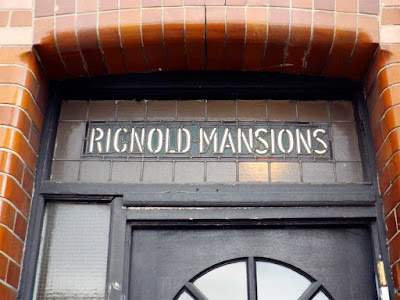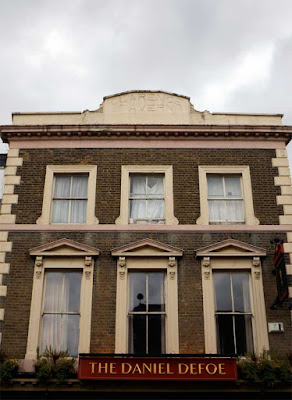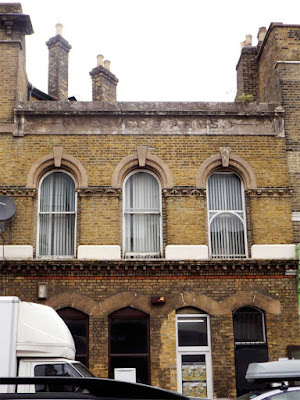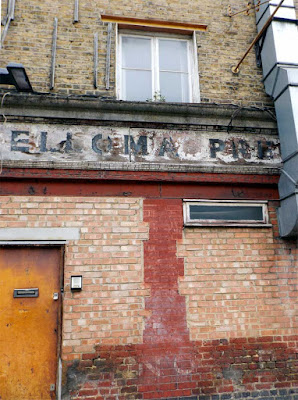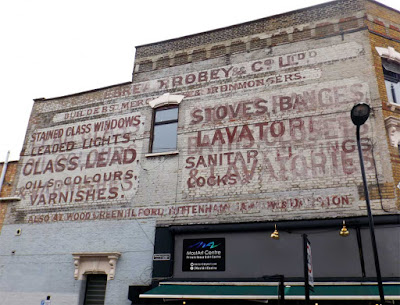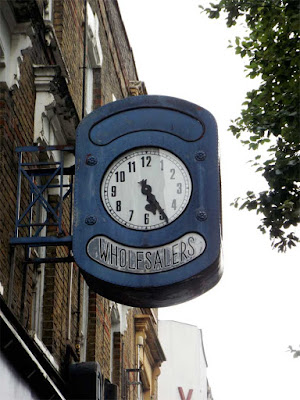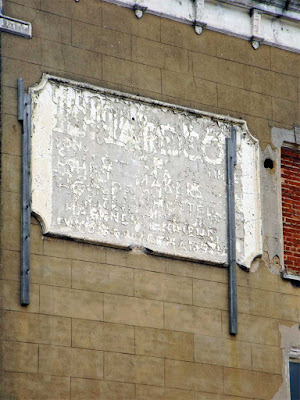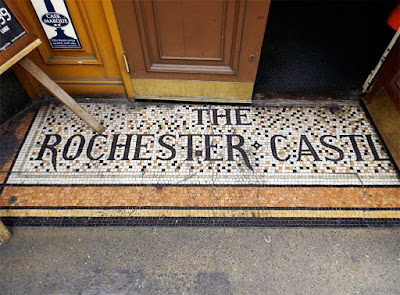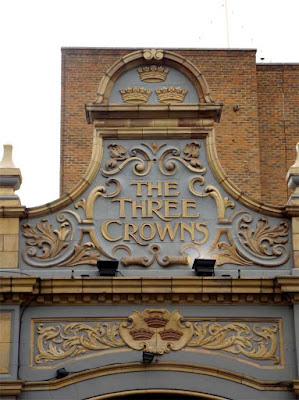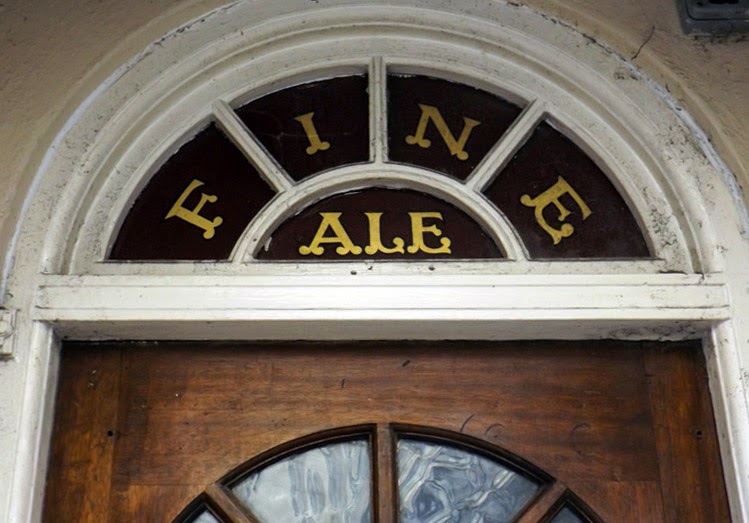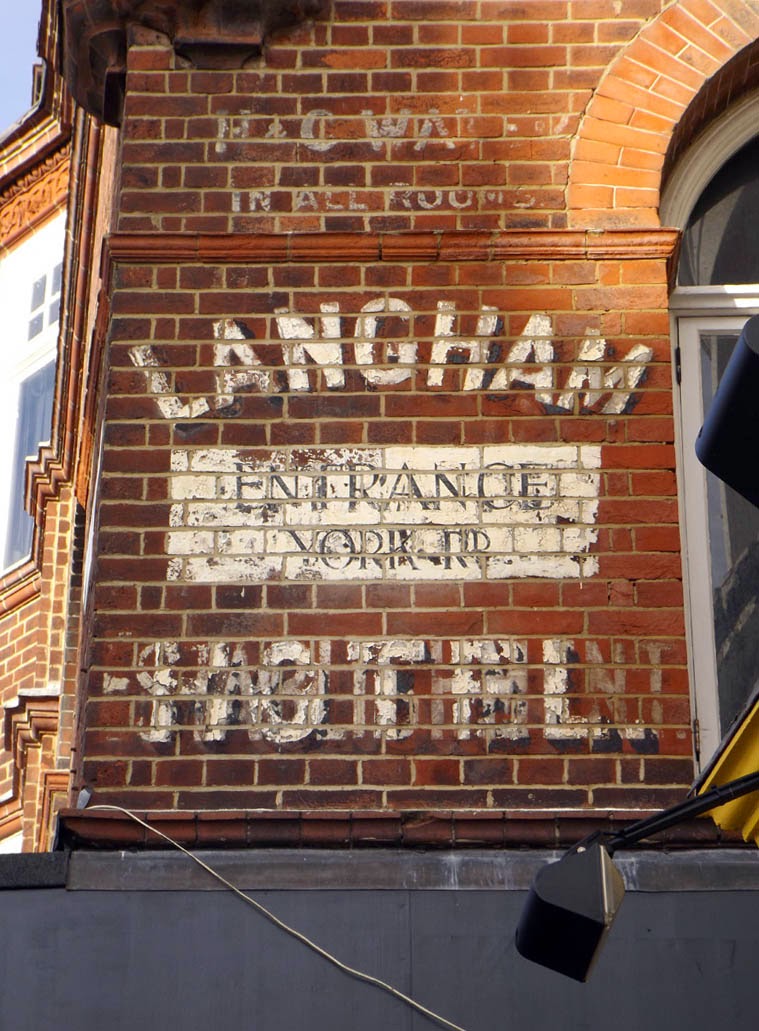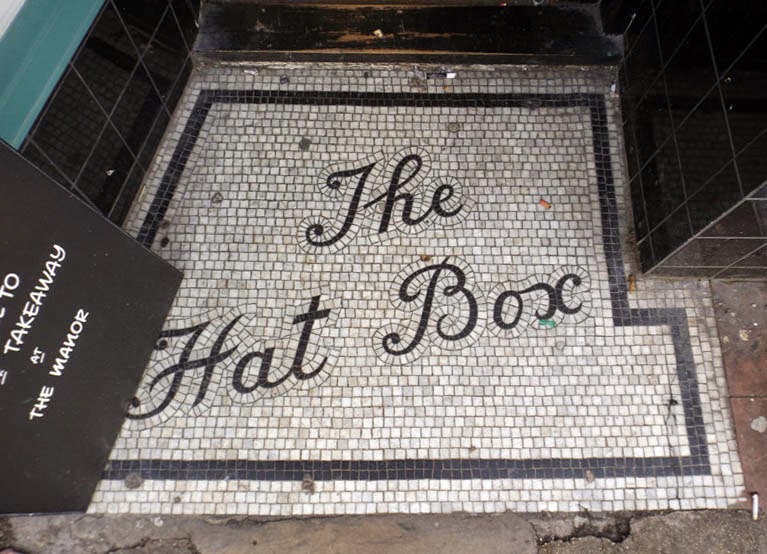Welcome to part two of my wanderings around Stoke Newington. During part one, I headed up and down the high street in search of interesting typography and wasn't disappointed. After a quick trip to the pub, I set out for Church Street, a road renowned as the epicentre of ghost sign activity in Stokey.
It wasn't long before I spotted my first sign on the corner of Fleetwood Street. Revealed during the removal of a billboard, the full text once read 'Hurstleigh's Bakery, Daren, Brown Bread. According to Spitalfields Life, Daren was the name of a flour mill based on the banks of the river Darent in Kent.
What little is visible of the type looks impressive, all slab serifs and chunky drop shadows - a real sign writers dream. It's a shame there doesn't seem to be a record of the whole thing!
Over the road on the corner of Lancell Street I spied a long, thin ghost sign on a chamfered corner wall. Though almost unreadable, it didn't stop me staring for five minutes trying to decipher it. The only words I can guess are 'Agents for' about half way down but sadly the rest remains a mystery.
Heading further up Church street, I stumbled across what are possibly the most famous set of ghost signs in London. The first was this striking palimpsest advertising no less than three products: Gillette Razors, the Westminster Gazette and Criterion Matches.
Along with Hovis (they of bread fame) Gillette were one of the first brands to fully realise the potential of painted adverts as a promotional medium and as such many examples of their signs can be found around London, painted in characteristic white and yellow on a bright blue background. At some point, the other two companies must have bought the rights to use the space and painted over the older signs. Time though, the great leveller, has seen fit to even them all out and the result is a spectacular collection of lettering styles, each marking different layers of history. Fantastic!
On the front of the same building I came across what is quite possibly London's most famous (and certainly one of its most charming) ghost signs. This is the sign that originally inspired the founder of GhostSigns, Sam Roberts, to start documenting these old adverts all the way back in 2006.
Roberts is a bit of a legendary figure among ghost sign enthusiasts, being one of the first people of the Internet age to start documenting London's ghost signs. Since then he has been involved in huge amounts of sign conservation work, written books on the subject and regularly gives guided ghost sign tours around London. All in all, an inspiring character and long may his good work continue. Be sure to check out his website at ghostsigns.co.uk
Anyway, back to the sign itself. The former occupants of the building appear to have been a company called Walker Bros, who specialised in the repair of fountain pens, particularly those of Watermans, a company who are still in the pen-making business today. In today's technological world it's difficult to imagine a time when you'd actually take your fountain pen to a shop to be repaired but evidently many people did.
The sign has got huge amounts of character, being painted in a shape that aims to make the best use of the available space. The long thin panel looks to have been repainted at some point, as behind the slightly crude looking 'Fount Pens Repaired' lettering it is possible to make out hints of some chunky, serifed lettering that has more in common with the rest of the sign.
The Watermans panel features a lovely lock up of title case lettering, in what looks like a flared serif style with a heavy drop shadow. The arched Watermans type is a nice touch too. Above this, the Walker Bros panel is inset on a beautifully drawn piece of notepaper with a fountain pen laid across for good measure. What more you you ask for?
Further up Church Street a blink-and-you'll-miss-it ghost sign clings on above Hazel Alterations on Marton Road. Though heavily faded and encircled by graffiti, it clearly advertises the services of Crane House Decorator in solid grotesque lettering.
After being spoiled by all the ghost signs I almost missed this nearby stained glass fanlight above the entrance to Rignold Mansions. It's always nice to see lettering incorporated into stained glass, especially when it takes on a stencil effect like it has here. Could this be the work of our old friends Cakebread, Robey & Co, Stoke Newington's favourite local stained glass suppliers? I'd like to think so.
Walking back down Church Street I managed to resist the temptations of the Daniel Defoe pub, but couldn't resist snapping its former name, The Clarence Tavern, carved into the top of the building in an engraver's Gothic style of lettering.
According to History of Stokey, the Clarence Tavern was built in 1860 and is the oldest pub building on Church Street. Over the years it has undergone numerous name changes including The Salmon and Trout and Steptoes. It was finally renamed the Daniel Defoe in 1999, in honour of the author who once lived nearby.
Further on I spotted another sign that had eluded me on the way up, this time belonging to A Rubenstein & Sons, aka 'Alf the Purse King', a purveyor of purses, pouches, handbags and wallets. By all accounts a charismatic fellow, Alf can be seen in his prime here courtesy of History of Stokey.
Painted in a combination of black, white and red, this sign would have been quite striking its day. Unfortunately you have to look closely to read the type now, but what can be seen looks to be a mixture of condensed and regular sans serif lettering styles. Alf the Purse King may be long gone but his spirit certainly lives on in Church Street.
Back in the direction of the station, on the corner of Cazenove Road a large furniture store occupies what was once a pub known as the Weavers Arms. The only clue to the pubs existence is some rather neglected lettering carved into the top of the facade of the building's side. I've not been able to find out too much about the Weavers, other than that it looks to have been opened sometime in the mid-19th century. Some rather fantastic views of the pub in it's glory days can be seen here and here, again courtesy of History of Stokey.
On the opposite side of Cazenove Road a fading shopfront caught my eye. Madame Lillie's was a once a corsetiere's shop, though very little information about it can be found online. The building was most recently home to an art gallery, though at the time of my visit it looked to be empty once again.
The faded sans serif lettering of the sign is in an advanced state of disrepair, though deep drop shadows are still visible on the individual characters.
Looking back down Cazenove road presented yet another ghost sign (see what I mean about Stoke Newington?) Bearing the just about readable legend 'Good judges drink John Brown Whiskies', the advert has suffered plenty of fading but hints of blue, white and red can still be made out. The lettering has been painted in a mixture of flowing script (think the old Wall's ice cream logo) and a blocky grotesque style. The only thing missing is a nice hand painted whisky bottle!
As an interesting footnote, this sign was recently under threat from the owner of the building but thankfully our old friend Sam Roberts stepped in to save the day. Read all about his adventure here!
Just when I thought Cazenove Road had given up all of its secrets I found one more sign hiding in a shady corner. Although difficult to make out in the above image, the sign reads 'F.Cooper, Job Master for Wedding Carriages, Broughams, Landaus, Cabs'.
The lettering looks to have been painted in a fairly standard grotesque style, however the use of key lines holding the word 'and' as well as arched and angled text forms a varied and eye catching layout.
Last but not least, I headed off Cazenove Road in the direction of the station. Although it had already been a more fruitful day than I could have imagined, Stokey provided one last ghost sign to add to my list. Despite only a strip remaining, it is possible to make out the words '6 tables' and 'embossers', as well as some hints of an older sign that has been painted over. Not the most spectacular sign of the day, but definitely one worth documenting.
So with that I jumped back on the Overground and headed home. As I've hopefully shown from these photos, Stoke Newington is one of the best places you can go if you're looking for ghost signs. Moreover, as an authentic taste of the old East End, it really does take some beating.
See you next time Stokey!


